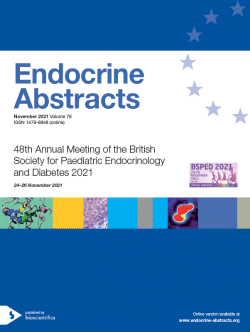
48th Meeting of the British Society for Paediatric Endocrinology and Diabetes
Online,
Virtual
24 Nov 2021 - 26 Nov 2021

Poster Presentations
Gonadal, DSD and Reproduction
ea0078p32 | Gonadal, DSD and Reproduction | BSPED2021
Using SITAR analysis to explore the impact of gonadotropin-releasing hormone analogues on the pubertal growth spurt in adolescents with gender dysphoria
Stack Annie , Butler Gary , Cole Tim
ea0078p33 | Gonadal, DSD and Reproduction | BSPED2021
Breast Satisfaction in adult women with Turner Syndrome – an international survey employing the BREAST-Q questionnaire
Idkowiak Jan , Smyth Arlene , Mundy Lily , Thorby-Lister Amy , Tsangaris Elena , Klaassen Anne , Nightingale Peter , Gleeson Helena , Hogler Wolfgang
ea0078p34 | Gonadal, DSD and Reproduction | BSPED2021
Characteristics of 46,XY complete and partial gonadal dysgenesis- A pilot study
Tadokoro-Cuccaro Rieko , Hughes Ieuan , Thankamony Ajay
ea0078p35 | Gonadal, DSD and Reproduction | BSPED2021
Two brothers with rare NROB1 mutation presenting with dichotomus pubertal presentations
Versha Rani Rai Dr , Noor Ibrahim Mohsina , Raza Jamal , Laghari Taj Muhammad , Khoso Zubair , Riaz Maira
ea0078p36 | Gonadal, DSD and Reproduction | BSPED2021
Neuroblastoma with concurrent X chromosome monosomy, a coincidence or an association?
S. Baranowski Elizabeth , Harding Eleanor , Gatz Susanne A. , McCarthy Liam , Chandran Harish , Godber Caroline , Denvir Louise , Turnbull Jenny , Idkowiak Jan , Randell Tabitha , Mohamed Zainaba
ea0078p37 | Gonadal, DSD and Reproduction | BSPED2021
Primary hypogonadism: better not just think of klinefelter!
Rosinha Ines , Ramos Fabiana , Santos Lea , Mirante Alice



